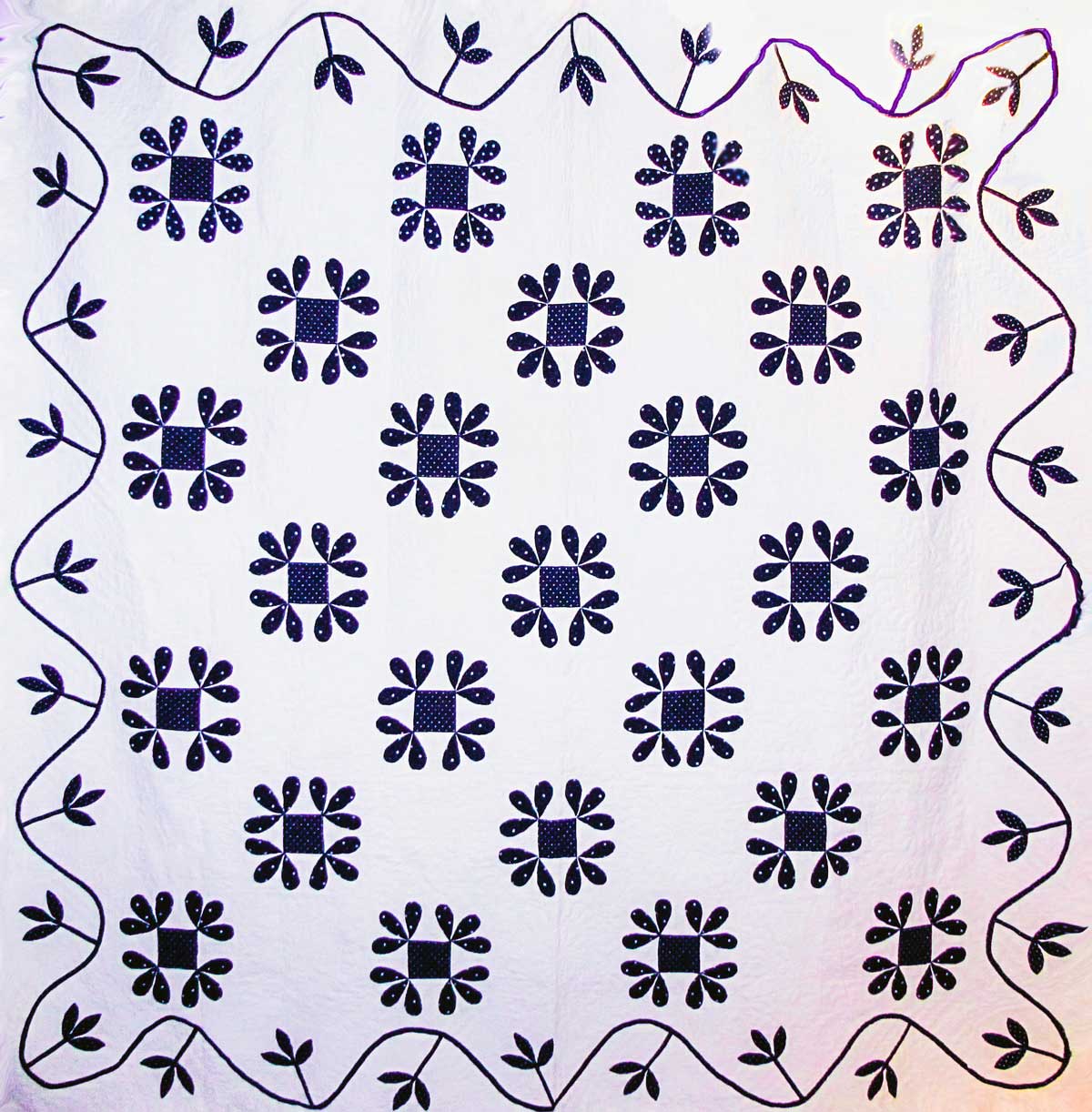The Honey Bee quilt block
October 2025
Covering Quilts
The Honey Bee quilt block
by Sandra Starley
Like many of today’s popular blocks, this pattern was first published during the 1930s Quilt Revival, a time when many antique quilt patterns were updated and named, or renamed several times with newspapers and other publications regularly featuring quilt patterns.
Almost all were said to have early American origins, even if just drafted in the writer’s studio; however, the origins of the Honey Bee pattern do go back to one of the earliest pieced blocks – the humble 9 Patch. In the early 1800s, as quilters began expanding beyond whole cloth designs, they started with simple geometric blocks like the 4 Patch and 9 Patch. A 19th-century Honey Bee quilt is shown here, an elegant circa 1860 indigo blue and white beauty.
This earlier version is based on a single 9 Patch block with appliqué details and is the pattern one finds when searching for the Honey Bee quilts made before 1930. The pattern dates back to the 1840s with a documented example that is date 1844 (on the quilt) and perhaps back to the 1830s.
The block has evolved throughout the years and become more complex. The current version actually features two different 9 Patches – an even 9 Patch center incorporated into an uneven 9 Patch block (a pleasing repetition and variation). The earlier versions tend to have a solid, unpieced center but with the same three appliqued leaves in each corner.
In looking at the pattern, one can almost hear the buzzing and see the bees flying home to their hive in the center of the block. Nature clearly was the inspiration for the Honey Bee moniker, first published in The Kansas City Star (1929) and soon followed by Ruby Short McKim (1930), Nancy Cabot (Chicago Tribune, 1933), and Hall and Kretsinger (1935). Nature also inspired the lyrical “Birds in the Air” name from thread makers Coats and Clark’s (1942). Perhaps the most unusual name for the block, “Blue Blazes” (Hall, 1935), was also inspired by some soaring bluebirds.

Detail of an 1870 Honey Bee “Birds and Bees” quilt. From the Sandra Starley collection. (Image courtesy of the author)

An 1860 Honey Bee; quilt from the Donna Starley collection. (Image courtesy of the author)
The pattern is adaptable for every skill level, and it is made using a number of techniques – hand or fusible machine appliqué and standard or strip piecing. It is the perfect teaching tool for basic piecing and appliqué methods, leading to its popularity in the sampler album classes of the 1980s and 1990s. For years, the National Quilting Association used the pattern as a test block for certifying teachers in their certification program as the pattern requires the makes to demonstrate skill in both piecing and applique. In “The Romance of the Patchwork Quilt,” historians Hall and Kretsinger noted it is “a charming example of combining piecing and applique. It is a bit less trouble to piece the entire block and applique the bee’s wings and bodies afterward.”
It appears that not many antique or vintage examples of the pattern were made based on the numbers that appear in the literature and online. A search of the Quilt Index for Honey Bee produced five quilts while a search for Ocean Waves showed 720 results, and many other patterns have thousands of results. I found an especially unusual example of this uncommon pattern, an antique Honey Bee that has been paired with delightful bird appliques. I hope you will be on the lookout for this charming pattern that just may buzz by while you are at an antique mall or searching online.
Sandra Starley is nationally certified quilt appraiser, quilt historian, and avid antique quilt collector. She travels throughout the U.S. presenting talks on antique quilt history, fabric dating classes and trunk shows as well as quilting classes. Learn more at utahquiltappraiser.blogspot.com. Send your comments and quilt questions to SandraStarley@outlook.com
Fall in love with New York – AQSG adventures, Part 3
February 2025 Covering Quilts Fall in love with New York – AQSG adventures, Part 3 by Sandra Starley Every fall, quilt historians and people who just love old and new quilts attend the annual meeting of the American Quilt Study Group (AQSG). So much happens during the...
Fall in love with New York – quilting adventures with the American Quilt Study, Part 2
December 2024Covering Quilts Fall in love with New York – quilting adventures with the American Quilt Study, Part 2by Sandra Starley Every fall, lovers of quilt history (old and new) meet to share research, treasures, and friendship at the Annual Meeting/Fall Seminar...
Fall in love with New York – quilting adventures with the American Quilt Study Group
November 2024Covering Quilts Fall in love with New York – quilting adventures with the American Quilt Study Groupby Sandra Starley What could be better than touring New York in the Fall with a lot of friends and antique quilts? Not much! Once again I had the...
Adventures in quilt rescue
October 2024Covering Quilts Adventures in quilt rescueby Sandra Starley Several years ago, I acquired a funky leaf appliqué quilt from an online auction. I put in a single small bid, then forgot about the item. I was surprised to find that I was the new owner,...
Journeys in quilt history – political patchwork quilts
September 2024Covering Quilts Journeys in quilt history – Political Patchwork Quiltsby Sandra Starley There is no better way to learn history and have fun than through examining, studying, and researching antique quilts. In preparation for my American Quilt...
Mission impossible – The International Quilt Museum heist
July 2024Covering Quilts Mission impossible – The International Quilt Museum heistby Sandra Starley Imagine being let loose in the most amazing quilt museum in the world and getting to pick out any quilt to take home. Well … This was my most recent quilty...

